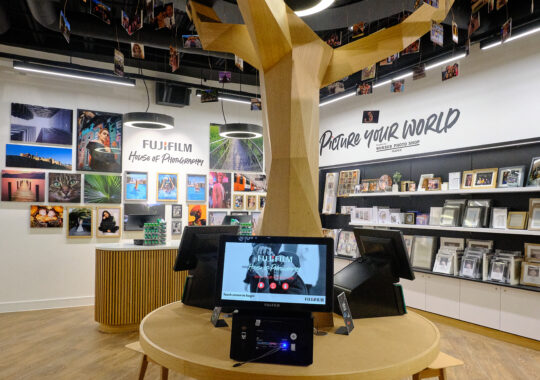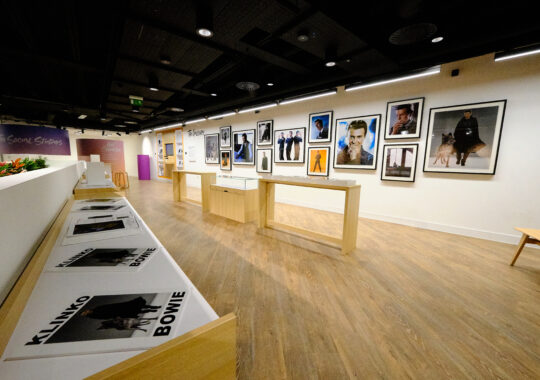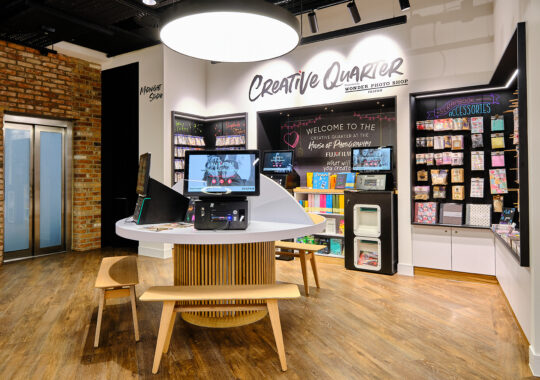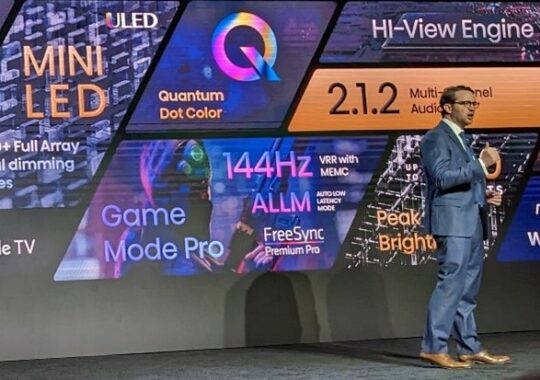Artificial Intelligence has the potential to super-charge a retailer’s creative assets and delivery process at a time when shoppers have less money to spend, products are more expensive, and shoppers expect detailed product information to help them make decisions. The rapid advancements in Computer Graphic Imagery (CGI), images created by AI algorithms, are occurring as we see retail brands seeking to create a much more complete, scalable, and immersive customer experience consistently curated across all physical stores, apps, and websites to create an omnichannel. Achieving this seamless interaction is dependent on retailers improving their overall product collateral and delivering richer media content through the support of AI and CGI. To compete for the shopper’s attention, retailers will need to adopt a digital content creation strategy that intersects with display and playback technologies to create a seamless buying experience.
Multifunctional Product Images
When shoppers encounter static product images currently used in e-commerce, they discover these images are often not very supportive for making practical decisions when buying items like clothes, makeup, or shoes, as these images exist in a sterile white background or stock image on a web page. Similarly, when buying large items like furniture online, it may be difficult to imagine what a sofa is going to look like in your house. Consumers turn to brick-and-mortar outlets to physically evaluate the products they researched online, but the in-store display images are typically not interconnected with the information found online or product data, such as stock availability and color choices, creating a disconnect in the shopper’s mind.
A traditional approach to product marketing, like utilizing high-quality images produced by creative content producers to generate blockbuster ads, like Michael Jordan in a pair of sneakers, is expensive and time-consuming. These high-resolution marketing images may be difficult to modify into a customer-focused experience. At the same time, companies are using low-resolution images provided by suppliers to make manufacturing and design decisions. These internal images are fast and cheap to produce but the viewing angles used for making manufacturing decisions are not intended for use in marketing to shoppers or making purchasing decisions.
This is where AI can be helpful. The combination of AI and CGI makes it possible to create dynamic and adjustable 3D images of products by blending high-resolution custom marketing images with technical criteria to support internal design coordination. Once two-dimensional images are transformed into accurate AI CGI three-dimensional representations, it is possible to do advanced manufacturing calculations, insert additional digital content, create variations of perspectives, overlay products onto different backgrounds, and insert other people into the scene. The high quality and flexibility of these AI-generated images allows them to be repurposed into promotional content for customers without requiring as much collaboration with human content providers. The key to unifying these image channels is transitioning to computer-generated content.
The areas where AI and CGI will have the most impact on the creation of product images are dynamic scene generation, image recognition, virtual try-on, and enhanced image search. Each of these areas is visual, so utilizing them in-store has a direct dependence on the digital signage technology used in retail establishments.
AI CGI Concepts for the Omnichannel
Dynamic Scene Generation
Dynamic scene generation removes the original background of a product image and replaces it with a virtual background image. The process makes it easy to erase undesirable elements in the original image and show the product in a completely different environment from the location it was photographed. It is also possible to add content and modify the scene beyond the original image to improve context. The result is dramatic, but it is only effective when it is seen on a monitor, which can be either a consumer shopping at home using their computer or mobile device or on a digital display in the store.
Image Recognition Tagging
Image recognition tagging simplifies asset management by aiding content identification and retrieval through techniques like image and metadata tagging. Leveraging machine learning, retail companies can automatically recognize products based on attributes such as shape and color, streamlining the transition from cataloging to content utilization. In parallel, the evolving landscape of image recognition involves strategically placed cameras that identify the products worn by customers, supporting trends in the collection of consumer data for informed product design. The discreet integration of cameras into the bezels of digital displays is making image recognition more efficient and with the potential to trigger signage players to display relevant content based on what shoppers are wearing, enhancing the in-store experience.
Enhanced Image Search
Enhanced image search uses AI to search images by visual cues rather than just text tags and can automatically filter images based on customer preferences and behaviors to help content developers manage and utilize their product catalogs more efficiently and effectively. This is easy to do online, but a similar enhanced search experience can be delivered to an in-store shopper as well. Imagine walking into a store with your preferences saved in the brand’s app, so you are shown products in your favorite colors and prints, along with stock availability in your size. For a retailer to create this shopping experience requires greater interaction with mobile devices or more interactive displays and content players with advanced triggers.
Virtual Try-On
Virtual Try-On uses AI-based Augmented Reality to manipulate product images to bridge the gap between e-commerce and physically trying on products in the store. Shoppers can superimpose product images over pictures of themselves or their homes right from their computer or mobile device. In-store, this technology can be utilized by installing displays where visitors can see a mirror-like view of themselves to try on clothes quickly and easily without the need for a changing room.
In-Store Impacts
Importance of Digital Displays in Retail
Competition in the retail market is high, meaning being to be first-to-market is critical. Images of new products need to be ready for distribution when the company announces a new product, so brands depend on quick image generation to stay a step ahead of their rivals. While CGI is revolutionizing the generation of digital images through software that is more efficient – almost automatic – the value of this process lies in the resulting images being seen by consumers on displays. Thus, investment in digital display technology in retail outlets aligns strategically with the generative capabilities of CGI product imagery. Which displays are best suited to this application? Traditionally, retail displays need to be bright (>500 NITs) and have wide (180-degree) viewing angles. As product content expands in quantity and utilization, displays will require more accurate color calibration, more impactful layouts, seamless integration with architecture, and meticulous integration with digital media players.
Importance of Digital Signage Players
The digital signage player is at the core of a successful AI-empowered omnichannel because it is the device that manages and controls how the content plays, allowing retail outlets to customize the shopper experience for their brand. A dedicated digital signage player is designed to manipulate both audio and video based on various triggers, changing the content based on a variety of factors, including presence, demographics, and interaction with objects. Having a variety of triggers for content playback is critical for immersing the customer in the curated experience. These players also capture data on what content was played in each location and when, among other metrics. For these reasons, signage players must stay in alignment with edge computing, hybrid cloud, and other AI advancements that impact content playout, data capture, and remote management.
Right Product, Right Shopper, Right Time
When people think of product marketing, they often think of creative ad campaigns, but in practice, great marketing content blends creativity and data. AI is allowing this industry to reduce the guesswork of consumer wants and needs and shift to a data-driven content creation process resulting in a wealth of content that responds to proven consumer desires and trends. Digitized content can also be refreshed infinitely, prolonging the life of the overall content portfolio. AI built into digital signage players and display technology can measure engagement, which will play a key role in achieving the retailer’s goal of understanding buying experiences so they can sell the right product to the right shopper at the right time.
The Future of Retail- What Comes Next
The impact of CGI, AI, and 3D imaging extends beyond the way we purchase goods and make product decisions to influence brand management, marketing, asset management, product design, and manufacturing. These tools enable retailers to create accurate product images more efficiently for internal use and unify e-commerce and in-store shopping experiences. Digital signage players and displays in retail stores will be directly affected as they enable immersive shopping experiences, a hallmark of omnichannel strategies.
In the future, the process may get reversed, with brands using customer responses to AI-generated images of products as a foundation for manufacturing. This approach blurs the line between reality and consumer expectations, but it also fosters a more sustainable manufacturing process, reducing waste, and cutting costs. The same digital images used to measure customer interest can be monetized themselves, providing value for the company through additional advertising opportunities, such as embedded marketing and product placement into films and TV series.
The potential of these AI tools extends to other industries as well. Travel and hospitality brands, automakers, and banks can benefit from advancements in digital content creation and immersive display technologies to align virtual and digital touchpoints and deliver more relevant, tailored, and unified experiences for consumers.
References & Examples of AI Digital Signage Products
The products below are just a few examples illustrating the technology associated with advancements in AI related to the retail market sector.
Computer Vision
Sharp/NEC partnered with GuiseAI to develop computer vision technology and build it into displays. Computer vision is a form of artificial intelligence where computers can “see” the world, analyze visual data, and then make decisions from it to gain an understanding of the environment and customer behavior through measuring footfall, demographics, apparel, drive-through, and engagement metrics. Understanding how customers interact with their products and services can be applied to airports, restaurants, office buildings, banks, museums, and retail outlets.
Holographic Transparent LED
Muxwave in partnership with content developer Igotcha created a holographic LED display using 3.9mm pixel pitch transparent mesh in an all-in-one frame that can be used as stand-alone “blades”, mounted on glass or as a transparent film. This technology blends digital experiences with elegant design for store displays. Complementing conventional large-format LED video walls and traditional digital signage are emerging technologies such as AR/VR, 3D projection mapping, and 3D Holographic spatial reality displays.
3D Foot Scanning Technology
Volumental developed a 3D foot scanning technology called FitTech that combines foot scans and retail purchase data via machine learning algorithms. FitTech captures data with scans to provide personalized email campaigns and custom e-commerce pages based on specific style and size recommendations.
3D Fans
HyperVSN for 3D Holographic LED fan technology uses ultra-fine pixel pitch and bright images with 16 million colors to allow content to appear to float in midair. The result is scalable to a variety of projects and is particularly useful for overhead images where suspending a large display can be challenging. The SmartV box controls the display and produces the visuals over ethernet. Multiple fans can be combined to make a large image and interactive and 3D content is possible.
















